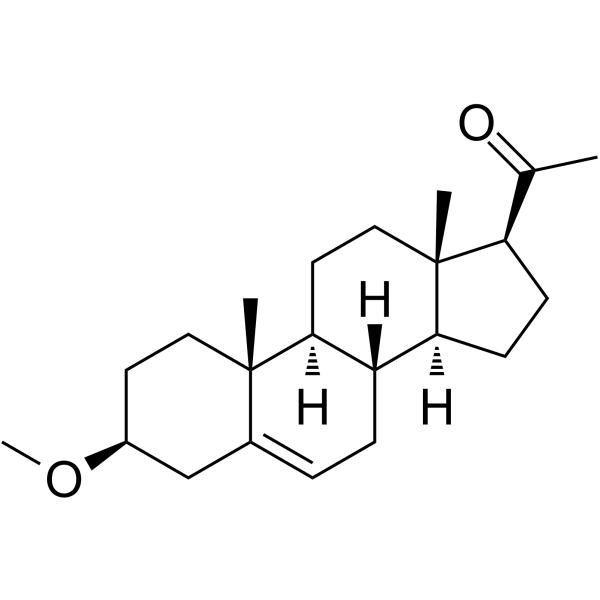
MAP4343
CAS No. 511-26-2
MAP4343( —— )
Catalog No. M28721 CAS No. 511-26-2
Map4343 is a 3-methyl ether derivative of pregnenolone. Map4343 binds to microtubule associated protein 2 (MAP2) in vitro and stimulates tubulin polymerization, resulting in enhanced neurite extension and protection of neurons from neurotoxic agents.
Purity : >98% (HPLC)
 COA
COA
 Datasheet
Datasheet
 HNMR
HNMR
 HPLC
HPLC
 MSDS
MSDS
 Handing Instructions
Handing Instructions
| Size | Price / USD | Stock | Quantity |
| 2MG | 43 | Get Quote |


|
| 5MG | 72 | Get Quote |


|
| 10MG | 125 | Get Quote |


|
| 25MG | 258 | Get Quote |


|
| 50MG | 425 | Get Quote |


|
| 100MG | 624 | Get Quote |


|
| 200MG | Get Quote | Get Quote |


|
| 500MG | Get Quote | Get Quote |


|
| 1G | Get Quote | Get Quote |


|
Biological Information
-
Product NameMAP4343
-
NoteResearch use only, not for human use.
-
Brief DescriptionMap4343 is a 3-methyl ether derivative of pregnenolone. Map4343 binds to microtubule associated protein 2 (MAP2) in vitro and stimulates tubulin polymerization, resulting in enhanced neurite extension and protection of neurons from neurotoxic agents.
-
DescriptionMap4343 is a 3-methyl ether derivative of pregnenolone. Map4343 binds to microtubule associated protein 2 (MAP2) in vitro and stimulates tubulin polymerization, resulting in enhanced neurite extension and protection of neurons from neurotoxic agents.
-
In VitroMAP4343 (40 μM; 15 or 30 min) stimulates microtubule polymerization in vitro.MAP4343 (30 μM; 2-8 d) stimulates nerve growth factor (NGF)-induced neurite outgrowth in PC12 cells.MAP4343 (20 μM; 1 h) protects against microtubule depolymerization induced by Nocodazole in PC12 cells .
-
In VivoMAP4343 (12 mg/kg; daily s.c. for 28 d) improves the recovery of locomotor function after spinal cord injury (SCI) in rats.MAP4343 (4 mg/kg; daily s.c. for 6 d) increases MAP2 levels in spinal cord after SCI in rats.MAP4343 (4 mg/kg; daily s.c. for 6 d) increases the size of lumbar spinal motoneurons' dendrite arbours after SCI in rats. Animal Model:Adult Sprague-Dawley male rats with spinal cord injuryDosage:12 mg/kg Administration:Daily s.c. for 28 days Result:Increased the number of animals able to walk with weight-supported plantar steps.Showed forelimb-hindlimb coordination at the end of the study.
-
Synonyms——
-
PathwayCytoskeleton/Cell Adhesion Molecules
-
TargetMicrotubule/Tubulin
-
Recptor——
-
Research Area——
-
Indication——
Chemical Information
-
CAS Number511-26-2
-
Formula Weight660
-
Molecular FormulaC44H67O4
-
Purity>98% (HPLC)
-
SolubilityIn Vitro:?DMSO : 25 mg/mL (75.64 mM)
-
SMILESC[C@](CC1)([C@@H](CC2)[C@H]3[C@H]1[C@@](C)(CC[C@@H](C1)OC)C1=CC3)[C@H]2C(C)=OC[C@](CC1)([C@@H](CC2)[C@H]3[C@H]1[C@@](C)(CC[C@@H](C1)OC)C1=CC3)[C@H]2C(C)=O
-
Chemical Name——
Shipping & Storage Information
-
Storage(-20℃)
-
ShippingWith Ice Pack
-
Stability≥ 2 years
Reference
1.Tran DN, Cramer N. Biomimetic synthesis of (+)-ledene, (+)-viridiflorol, (-)-palustrol, (+)-spathulenol, and psiguadial A, C, and D via the platform terpene (+)-bicyclogermacrene. Chemistry. 2014 Aug 18;20(34):10654-60.
molnova catalog



related products
-
Thiabendazole
Thiabendazole is an Antihelminthic. Hiabendazole is a benzimidazole compound that acts as a fungicide and is reported to have aneugenic effects.
-
PST-1P
PST-1P is a photoswitchable inhibitor of microtubule with EC50 of 0.7 uM under 390 nm irradiation in the MDA-MB-231 human breast cancer cell lines.
-
Estramustine
Estramustine is a nitrogen mustard linked to estradiol, usually as phosphate. Estramustine has been used to treat prostatic neoplasms; also has radiation protective properties.



 Cart
Cart
 sales@molnova.com
sales@molnova.com


